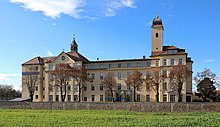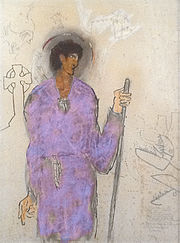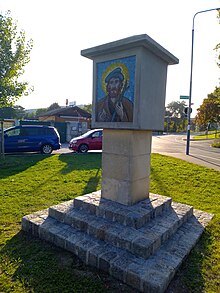Koloman (saint)

The Holy Koloman (* Ireland ; † 17th July 1012 at Stockerau ) - also: Coloman, Kolman - said to have been an Irish prince, who on a pilgrimage to the Holy Land was captured in Stockerau and executed.
Life

from 1986
Not much is known of the saint's life. The legend says that he was an Irish prince or itinerant preacher who on a pilgrimage to the holy places in Jerusalem went. At that time there were a number of arguments between King Henry II and Duke Bolesław I Chrobry of Poland. Due to his strange appearance, Koloman was mistaken for a Bohemian spy and arrested near Stockerau in Lower Austria. After a martyrdom , he was hanged on a dry elder tree between two murderers . This scene is also shown on the Babenberger family tree , a panel painting six by four meters wide, which was created by Hans Part between 1489 and 1492. In the garden of the St. Koloman Monastery in Stockerau you can see an elderberry bush that has grown into a tree, which has already sprouted many times and which is said to be the elderberry in question. According to a lesser-known legend, Koloman was not hanged but slain.
As a death row inmate, he was not buried. However, even after some time, his body still showed no signs of decay and, according to legend, numerous miracles soon occurred. Therefore, Koloman was finally buried for the first time in the then relatively newly built church in Stockerau, which is located in the area of today's monastery, whereupon numerous miracles are said to have happened at his grave. As a result, Koloman was transferred two years after his death to the then residence of the Babenbergs in Melk and was buried there on October 13, 1014, which is still his feast day today. In addition, the convent of Melk Abbey and the sisters in St. Koloman Monastery also celebrate the feast day on July 17th, which was much later.
Early reports on the life of St. Koloman can be found in Thietmar von Merseburg's chronicle from 1017 and in the Passio sancti Cholomanni by the Melk abbot Erchenfried († 1163).
Adoration
Entombment and relics
Margrave Heinrich I became aware of Koloman through the worship of the people . A commission checked the miracles and had the tomb opened. Koloman was found not decomposed. Heinrich had Koloman's body transferred from Stockerau to Melk , where he was buried a second time on October 13, 1014 by the Eichstatt Bishop Megingaud in St. Peter's Church outside Melk Castle. This is reported in the Passio S. Cholomanni , which dates from the middle of the 12th century.
In May 1244, Pope Innocent IV wrote to the Bishop of Passau that Koloman's Memorial Day, the so-called Kolomanitag, should be celebrated as a holiday in all of Austria and the adjacent provinces due to the miracles reported by Duke Friedrich II at Koloman's grave. This was part of Friedrich's efforts to get his own regional bishopric. A transfer of Koloman's bones to the bishopric to be founded was also planned. These plans were thwarted by the death of Friedrich.
In the meantime the bones had been brought to Hungary under pressure from the Hungarian king. However, Koloman was soon brought back because the illegal implementation should have caused major natural disasters. The head is said to have remained in Székesfehérvár , but without the lower jaw . The lower jaw was captured in the Kolomanimonstranz in 1752 . It is shown annually on Colomani Day. Rudolf IV had a splendid tomb erected for Koloman in 1362. It was also he who had the Kolomanistein walled up in the bishop 's gate of St. Stephen's Cathedral in Vienna in 1361 . Since the axes of the Virgil Chapel are aligned with the position of the sun on the name day of Koloman, it is assumed that a transfer of the bones to St. Stephen's Cathedral was planned. The colomanist stone is set in brass and bears the inscription: “ Hic est lapis, super quem effusus est sanguis ex serratione tibiarum S. Colomanni Martyris, quem huc collocavit illustris Dominus Rudolphus IV. Dux Austriae ”. A lead case with a strip of parchment was found behind the stone. According to this, several relics are said to have been walled in behind the stone . The stone itself is a contact and secondary relic, which is said to have shown traces of blood Coloman's still visible at the time of installation.
The bones of the saint were reburied at least one more time, because today they are in the left front side altar of the Melk Collegiate Church .
Adoration outside of Austria
The veneration of Saint Koloman spread not only in Austria, but also in the Electoral Palatinate , in today's Bavaria, Swabia and Ireland where numerous churches are consecrated to him, and especially in the Kingdom of Hungary , where the bones of the saint were temporarily abducted and in the Hungarian coronation city Stuhlweissenburg (Székesfehérvár) were kept. Because of this veneration, the eldest son of Géza I, King of Hungary from 1074 to 1077 from the house of the Arpaden, was named after the Austrian saint Koloman. Prince Koloman followed as King of Hungary in 1095 , ruled there until 1116 and left a descendant in the Byzantine Empire who bore the surname Dukas Kalomanos. Another name bearer from the House of the Arpaden was Prince Koloman ( Hungarian language : Kálmán) the second son of King Andrew II of Hungary , who ruled as the first crowned king of Galicia and Lodomeria from 1212 to 1219 and later to 1241 Duke of Slavonia was.
Remembrance day
The day of commemoration and name of St. Koloman is October 13th . It has been celebrated since 1244. On this day, the Kolomanikirtag has also been held in Melk since 1451 .
iconography
His attributes are those of the pilgrim (hat, coat, staff, bottle) and often a noose in his hand.
Patron saint
From 1244 to 1663 Koloman was the patron saint of Austria above and below the Enns . Then he was replaced as the patron saint of the country by St. Leopold . However, he is still the patron saint of the cities of Stockerau and Melk and of Melk Abbey .
Koloman is also the patron saint of those sentenced to death by hanging , travelers and cattle . He should also provide support against diseases, head and foot ailments, plague , storms, fire, rat and mouse plagues.
Patronage

Many churches in Austria, Bavaria and Swabia are dedicated to St. Koloman. The castle chapel of the Aggstein ruins was consecrated to Saints Koloman and Georg. In Laab im Walde one already existed before 1200 Colomann Chapel, the parish church is dedicated to him. As early as the 15th century, a chapel was built near Schwangau in Bavaria at the place where St. Koloman is said to have rested.
The Kolomanskloster are the Melk Benedictine Abbey and the Stockerau Abbey of the Steyler Missionary Sisters (formerly Franciscans).
In Austria alone, there are more than 15 known colomangnaden sites, such as the Kolomanistein near Eisgarn. The Kolomani fountain in Melk's old town is also dedicated to him. The Kolomansberg in the Salzkammergut is also named after the saint.
literature
- Karl Lechner: The Babenberger. Margraves and Dukes of Austria 976–1246. 6. unchangeable Edition. Böhlau, Vienna et al. 1996, ISBN 3-205-98569-9 .
- Gerhard Floßmann (ed.): City book Melk. Culture and Museum Association Melk, Melk 1998, ISBN 3-9500896-0-8 .
- Friedrich Wilhelm Bautz : Coloman (Colman, Kolman). In: Biographisch-Bibliographisches Kirchenlexikon (BBKL). Volume 1, Bautz, Hamm 1975. 2nd, unchanged edition Hamm 1990, ISBN 3-88309-013-1 , Sp. 1100.
- Klaus Wankmiller: Kolomans representations in the Ausserfern. A search for traces of the 1000th anniversary of the saint's death. In: Extra Verren - Yearbook of the Museum Association of the Reutte District 7 (2012), ISSN 1992-0261, pp. 25–42.
Web links
Individual evidence
- ↑ Thietmari chronicon a. 919-1018 VII, 54. In: Georg Heinrich Pertz u. a. (Ed.): Scriptores (in Folio) 3: Annales, chronica et historiae aevi Saxonici. Hannover 1839, p. 860 ( Monumenta Germaniae Historica , digitized version )
- ↑ Passio sancti Cholomanni. In: Georg Heinrich Pertz u. a. (Ed.): Scriptores (in Folio) 4: Annales, chronica et historiae aevi Carolini et Saxonici. Hanover 1841, pp. 674–678 ( Monumenta Germaniae Historica , digitized version )
- ↑ European Family Tables , New Series, Volume II. Plate 154;
- ↑ European Family Tables New Series, Volume II. Plate 178
| personal data | |
|---|---|
| SURNAME | Koloman |
| BRIEF DESCRIPTION | allegedly an Irish prince who is venerated as a saint in Austria |
| DATE OF BIRTH | 10th century |
| PLACE OF BIRTH | Ireland (island) |
| DATE OF DEATH | 17th July 1012 |
| Place of death | Stockerau |










